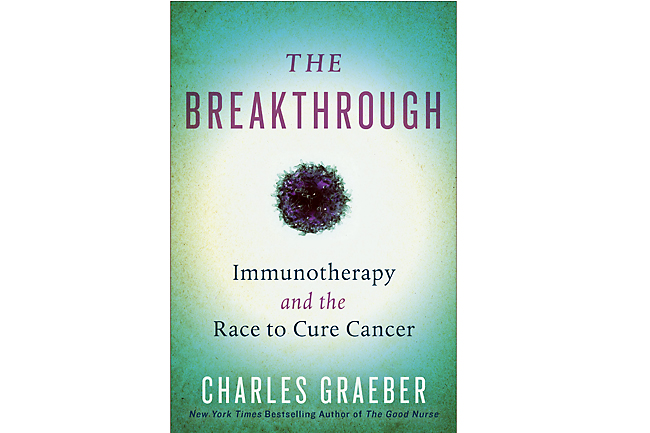Book World: A new book about cancer offers something rare – realistic hope
Breakthrough: Immunotherapy and the Race to Cure Cancer by Charles Graeber. – TWELVE.
.
THEY sure don’t do human studies like they used to. After a young physician at New York Hospital named William Coley lost a patient to cancer in 1890, he began combing through hospital records for clues about who had survived the usually fatal disease. Reading one case, Coley noted that the patient’s seemingly miraculous cure followed a raging strep infection that appeared to melt away the man’s head-and-neck sarcoma.
Intrigued, Coley got a chance to test his hunch (no ethics board’s approval or patient’s informed consent required!) the following year, with a man suffering from a neck tumour and given only weeks to live. Coley “basically winged it,” journalist Charles Graeber tells us in The Breakthrough: Immunotherapy and the Race to Cure Cancer.
The good doctor injected the patient first with a little bacteria and then with a lot, at one site on his body and then another, and finally with bacterial toxins collected from a corpse (“the good stuff, potent and fresh,” Graeber reports) and shot right into the ghastly tumour.
After suffering near-lethal fevers, the patient rallied. His tumour seemed to break down before Coley’s eyes. Although infection-causing injections killed two of Coley’s next 12 patients, the doctor was convinced: If the immune system can be unleashed, it will kill tumours.
Coley was 100 years ahead of science’s understanding of the immune system. He was dismissed as a charlatan, and once he started bottling and peddling his cancer-fighting toxins, he was also called a snake oil salesman. Generations of oncologists and cancer biologists either heard nothing about Coley’s observations or lumped them together with cancer quackery.
.
ADS by Cloud 9:
.
– SPACE RESERVE FOR YOUR ADVERTISEMENT –
.
.
Immunology became a vaguely disreputable backwater in cancer research. Stalwarts like Steven Rosenberg kept it alive, but they seemed to epitomise the cycle of soaring hopes and dashed dreams: interferon, interleukin-2 and other immune-boosting drugs came – were fleetingly heralded – and mostly went.
It took an immunologist, not a cancer biologist, to crack the code. James Allison realised it wasn’t that the immune system needed boosting. Instead, molecules on tumour cells that thwarted the immune system needed to be disabled. Allison figured out how to disable those molecular brakes, or checkpoints, and allow the immune system to rip: His discovery led to the first approved ‘checkpoint inhibitor’ cancer drug, in 2011, and won him a share of the 2018 Nobel Prize in medicine.
If you read about cancer discoveries in the media and have a good memory, you are likely to react to the title of Graeber’s book with a lot of eye rolling and maybe some understandable anger.
Despite decades of cancer “breakthroughs” – potent chemotherapies and molecularly targetted drugs – roughly 600,000 people in the United States (US) die of cancer every year.
But Graeber makes a persuasive case that cancer immunotherapy has earned the b-word. With checkpoint inhibitors like Allison’s, which target the molecular brake called CTLA-4, followed by inhibitors of brakes called PD-1 and PD-L1 and then genetically engineered T cells called CAR-Ts, once-hopeless cancer patients are actually achieving something physicians have been loath to utter: a cure.
Breakthrough is full of gripping stories of white-knuckle experiments, of mice that lived, of pioneers who had to wrangle fellow scientists into investigating the interaction of the immune system and cancer. These determined few valiantly fought a cancer hierarchy that viewed the whole thing as a dead end.
Gatekeepers at prestigious science journals rejected research papers in the stubborn belief that the immune system can’t attack cancer – data be damned. Eventually, the data could not be denied. Graeber deserves credit for telling stories of both the successes and the failures of immunotherapy. Graeber meets the goal of every writer: to leave the reader wanting more rather than less. There are very few places in this brisk account where you slog through more biochemistry than you ever wanted to see in several lifetimes.
This chapter of the cancer immunology story still needs writing, as do other tales of the research and the scrambling – and catch-up-playing – of multiple drug companies.
For now, Graeber has given us a riveting account of science that truly deserves an accolade that has been all too frequently awarded, but almost never actually achieved, in cancer research: Unleashing the immune system on tumours is indeed a breakthrough. – The Washington Post
| Sharon Begley |
.
ADS by Cloud 9:
.
– SPACE RESERVE FOR YOUR ADVERTISEMENT –
.
.
 All photographs, news, editorials, opinions, information, data, others have been taken from the Internet ..aseanews.net | [email protected] | For comments, Email to : BOOKRICH @ yahoo.com / Contributor
All photographs, news, editorials, opinions, information, data, others have been taken from the Internet ..aseanews.net | [email protected] | For comments, Email to : BOOKRICH @ yahoo.com / Contributor









